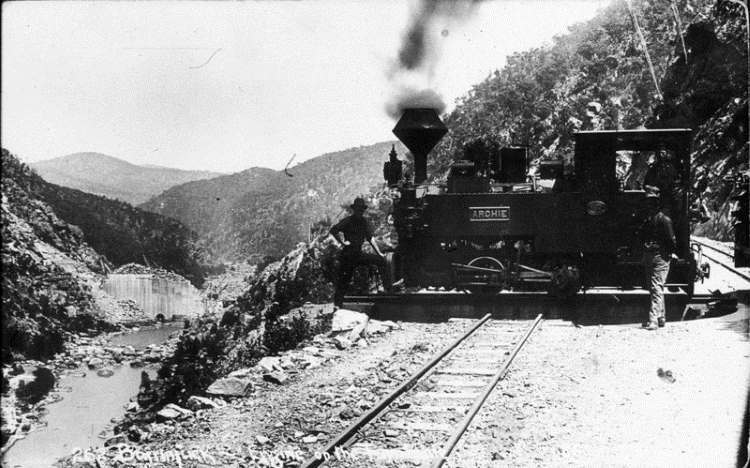Krauss Locomotives in Australia
Lokomotivefabrik Krauss & Co of Munich, Germany built locomotives for a wide variety of gauges and shipped them to owners spread across the world. Locomotives from this builder were built in three factories; two were in Munich, Germany and one was in Linz, Austria.
In 1931 the company amalgamated with another German locomotive builder, J. A. Maffei A G and the joint company continues building locomotives and other railway equipment to this day.
The Krauss locomotives that came to Australia were all narrow gauge tank locos with wheel arrangements ranging from 0-4-0 to 0-6-2 and were ideal for industrial and light railway use.

Archie, a 610 mm gauge Krauss 0-4-0T locomotive – b/n 6063 of 1908 – was ordered by the NSW Public Works Department to work along with other Krauss locomotives on the construction of Burrinjuck Dam. Photo courtesy of the NSW State Library
The first, the last and those in between
The first Krauss locomotive to arrive in Australia was B/N 1824 in 1888. This 600 mm gauge locomotive was displayed at the Melbourne Centennial Exhibition and was then sold in 1889 to an unknown buyer. However, by 1900 the ownership of the locomotive had passed to the WA Builder’s Lime & Stone Co in Perth, Western Australia.
Ownership of this locomotive changed several times over the years and it is thought to have been scrapped sometime around 1950.
The final Krauss locomotive to arrive in Australia was b/n 6927 in 1914. The buyer for this 610 mm gauge locomotive was the Corrimal-Balgownie Coal Company in NSW. It remained in service until 1944 and was then placed in storage. In 1971 the chassis of this locomotive passed into private ownership.
In between those two locomotives another 47 Krauss locomotives were delivered in gauges ranging from 610 mm to 762mm.
Spread far and wide
Buyers for these locomotives came from all states of Australia (with the exception of the Northern Territory) and included miners, quarries, contractors, sugar mills, the NSW Public Works Dept., the Tasmanian Government Railways and the Maroochy Shire Council in Queensland.
While some of these hardworking little locomotives remained fairly close to where they were first used, many passed through the hands of multiple owners and saw service in a wide range of industries spread across Australia.
For example, b/n 2589 was a 610 mm gauge 0-4-0T that first arrived in Australia in 1891 and, while there is no clear evidence of who originally purchased the locomotive is is thought that it might have first seen service in the Tarrawingee flux quarry near Broken Hill in NSW.
By 1898 the locomotive was owned by the Tasmanian Government Railways and around 1906 it was sold to the Victorian Public Works Department who used it on the construction of the Coode Canal. In 1908 it was sold to it’s final owner, the Corrimal-Balgownie Coal Company in NSW and it remained in service with that owner until 1933.
Another example of how far these locos traveled is another 610 mm 0-4-0T, b/n 3267 of 1895. This locomotive entered service in 1896 wiuth the Mt Lyell Mining and Rwy Company in Tasmania.
By 1908 ownership had passed to Wadey & Co who used it in South Australia on the construction of the Heatherton Asylum and the construction of the Metropolitan Abattoir. By 1911 the locomotive was in Queensland working hauling sugar can to the Mourilyan Sugar Mill and it remained there till it was dismantled in 1955.
Turning three into two
Combining bits of two worn out steam locomotives to produce one with some life left in it is not unusual and the Krauss locomotives that came to Australia were not immune to the practice. In 1959 b/n 5800 of 1907 was dismantled and various parts were used to repair another Krauss loco … 4087 of 1899 … but that wasn’t the end of b/n 58001.
In 1970 the frame and wheels from b/n 5800 were combined with the boiler and bodywork from b/n 5682 of 1906 to make a complete and operational locomotive.
While many of these Krauss locomotives have now been scrapped a number have passed in private and museum ownership and some even remain in operational so their preservation is assured.
References
Macdonald, B 2000, ‘Krauss Locomotives in Australia, Light Railways, June, pp. 10-18
1. Rails Tasmania website, Preserved Tasmanian Steam Locomotives http://www.railtasmania.com/info/presstea.htm